WATER for Class 6 SCIENCE
INTRODUCTION
Hamare chapter ka name hai “Water” toh sabse pehle hum jante hai ki water kya hai?
Water ek precious, fundamental aur sabse necessary substance mein se ek hai jiski wajah se earth par life possible hai. Hamare planet earth par bahut saara water present hai, iska almost two third part water se hi covered hai. Toh iss chapter mein hum padhenge aur janege ki hum daily kitna water use karte hai, kahan-kahan use karte hai, woh water aata kahan se hai, water cycle kis tarah chalta rehta hai, etc. Yahan hum iske baare mein bhi padhenge ki agar jyada rain hogi toh kya hoga aur agar bahut less rain hogi toh kya hoga. Rainwater harvesting aur usko conserve karne ke methods ke baare mein bhi hum iss chapter mein padhenge.
How Much Water Do We Use?
Hamein bahut saari activities aur needs ke liye water chahiye hota hai. Eg- Hamein apni daily activities jaise drinking, brushing, washing, bathing, cleaning, etc. ke liye water chahiye hota hai. Iske alawa bhi hum bahut things use karte hai jinki manufacturing ya growth ke liye bhi hamein water chahiye hota hai. Eg- Hum daily grains, vegetables, other food materials use karte hai, hum natural fibres se bane fabric use karte hai, lekin kya hamne kabhi socha hai ki inn sabko grow karne ke liye bhi toh water ka hi use hota hai. Toh yeh water kaha se aata hai? Iske baare mein hum next topic mein padhenge ki yeh water kaha se aata hai?
Where Do We Get Water From?
Hum daily jitna bhi water use karte hai woh hamein rivers, lakes, ponds, wells, etc. se milta hai. Yeh hamare homes mein, aur saare places par different ways mein aata hai lekin ultimately iska source same hi hota hai. Hamare homes mein jo water aata hai woh bhi river ya well se hi liya jata hai aur pipes ke network ke through homes mein aur baki places par supply kiya jata hai. Ab hamne yeh toh jaan liya ki sabhi places par supply hone wala water ponds, rivers, etc. se aata hai lekin kya hamne kabhi yeh socha ki ponds, rivers, lakes, etc. mein water kon fill karta hai?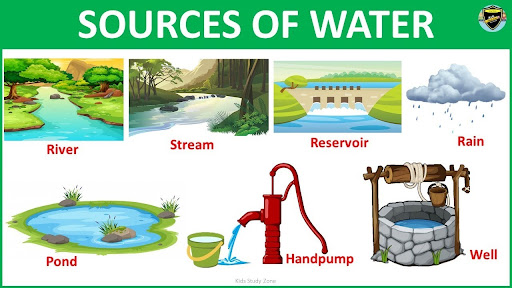
Jaisa ki hamne upar bhi padha ki earth ka two third part water se covered hai lekin kya yeh sara water use karne ke liye suitable hai?
Nahi yeh sara water hamare liye usable nahi hai kyonki inme se mostly water seas aur oceans mein hota hai aur yeh salty water hota hai jisko hum saline water bhi kehte hai, yeh hamare drinking, domestic, agricultural aur industrial needs ke liye unfit hota hai. Lekin fir bhi oceans hamare sources ko water supply karte hai. Lekin fir hum jo water use karte hai woh salty kyo nahi hota?
Iska answer hamein apne next topic mein milega, waha hum janege ki inn sabhi sources mein paani kaha se aata hai.
Water Cycle
Water cycle ek aisa circle of processes hota hai jisme earth aur atmosphere mein water ka regular circulation hota rehta hai.
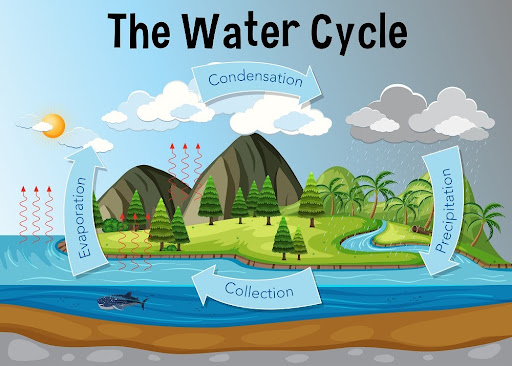
Disappearing Trick of Water
Hum jab bhi kisi open surface par water spill karte hai toh kuchh der baad woh water disappear ho jata hai, wet clothes bhi kuchh time mein dry ho jate hai, aise aur bhi bahut saare examples hum daily life mein dekhte hai lekin kya hamne kabhi yeh socha ki aisa kyo hota hai?Aisa water ke evaporation ki wajah se hota hai. Ab yeh evaporation kya hota hai?
Evaporation: Water ke heat hone ki wajah se uska vapours (gaseous state) mein change hona evaporation kehlata hai.
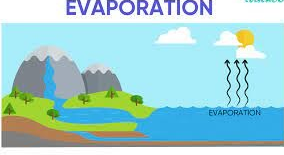
Water vapours evaporate ho kar air mein chale jate hai. Water ko hum jitna jyada heat karte hai woh utna hi fast evaporate hota hai. Eg- Hum dekhte hai ki road par agar day time mein water spill kiya jaye aur night time mein water spill kiya jaye toh night ke comparatively day time mein woh water jaldi evaporate ho jata hai. Evaporation itna slow process hai ki agar hum sunlight mein ek water se filled bucket rakh de toh hum rarely usme se water ka evaporation notice kar payenge.
Ab hum dekhte hai ki kya evaporation ke alawa aur bhi koi process hai jisse water vapours mein convert hota hai.
Loss of Water by Plants
Hum jante hai ki plants ko apna food prepare karne ke liye aur grow karne ke liye water ki jarurat hoti hai. Plants jo bhi water lete hai usme se kuchh amount of water toh food banane ke liye use kar lete hai aur kuchh water apne different parts mein rakh lete hai. Ab jo bacha hua water hota hai plants usko water vapours ki form mein air mein transpiration ke process ke through release kar dete hai.Transpiration: “Transpiration is the biological process by which water is lost in the form of water vapour from the aerial parts of the plants.”
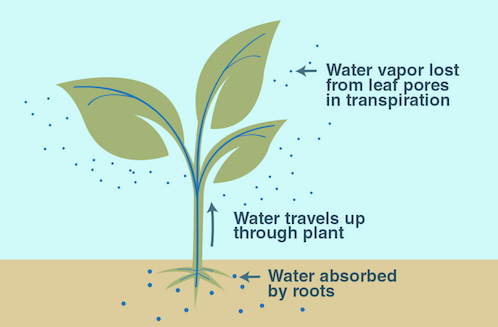
Evaporation aur condensation ke process ke through water loose toh ho jata hai lekin woh hamare paas wapas kaise aata hai?
Yeh water hamare paas condensation ke process ke through wapas aata hai jiske baare mein hum next topic mein padhenge.
How are Clouds formed?
Ab hum jante hai ki clouds kaise bante hai. Iske liye pehle hum condensation ka process samajhte hai.Condensation: Yeh ek process hai jisme water vapour cool ho kar liquid form mein convert ho jate hai, isko condensation kehte hai.
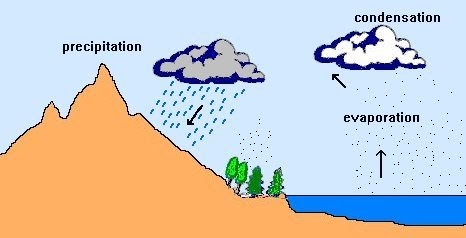
Earth ke surface par hum jitni height par move karte jaate hai air utni hi cool hoti jati hai. Air jitni upar move karti jati hai utni hi cool hoti jati hai aur ek time par woh itni cool ho jati hai ki usme present water vapours condense ho kar tiny water droplets form karte hai. Yeh tiny water droplets air mein float karte rehte hai aur hamein clouds ki tarah appear hote hai.
Yeh tiny water droplets jab collect hoti rehti hai toh ek time par yeh itni heavy ho jati hai ki yeh water droplets fall karna start kar deti hai jisko hum rain kehte hai. Kuchh special conditions mein yeh water droplets freeze bhi ho jati hai aur hail ya sno ki tarah niche aati hai.
Ab tak hamne dekha ki water evaporation aur transpiration ke process ke through air mein jate hai, unse clouds form hote hai aur woh rain, snow ya hail ki form mein wapas earth par aa jaate hai.
Back To The Oceans
Land surfaces ocean level se upar hote hai aur rain, snow and hail ki form mein jo water earth par aata hai woh baad mein flow ho kar oceans mein wapas chala jata hai aur oceans refill ho jaate hai. Yeh bahut saare ways se hota hai-
Mountains se snow melt ho kar water mein convert hoti hai aur yeh water stream ki form mein flow karke river mein jata hai. Kuchh water jo rain ki form mein land surface par padta hai woh bhi flow karke rivers mein chala jata hai. Mostly rivers land par long distances cover karti hai aur fir sea ya oceans mein ja kar mil jati hai aur kuchh rivers ka paani lakes mein bhi chala jata hai.
Rainwater lakes aur ponds ko refill kar deta hai. Iss water ka kuchh part ground mein seep in ho jata hai jisme se kuchh amount of water transpiration aur evaporation ke process ke through wapas air mein aa jata hai. Open wells mein bhi ground water se hi paani aata hai; lakes, handpumps, tubewells, etc. mein bhi paani yahi se aata hai.
Hum aaj-kal ground water ka bahut use kar rahe hai isliye iska level bahut down ja chuka hai jo bahut chinta ki baat hai.
Aaj-kal har jagah concrete roads ban gaye hai jiski wajah se water ground mein seep in nahi ho pata, iska ek reason deforestation bhi hai kyonki plants ki absence mein water soil ke andar nahi ja pata woh directly flow kar jata hai aur apne sath soil ki top fertile layer ko bhi le jata hai. Inhi reasons ki wajah se ground water ka level increase nahi ho pa raha aur jo ground water available hai woh log use karke khatam karte ja rahe hai.
Ab hum ek bar water cycle ka overview dekh lete hai ki isme kya kya hota hai.
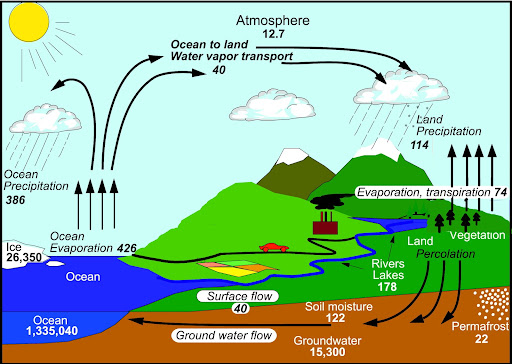
What If It Rains Heavily?
Rainfall har place par alag time, duration aur alag amount mein hoti hai. Kisi place par toh poora year rain hoti rehti hai aur kahi par kuchh hi din hoti hai. Hamari country mein mostly rainfall monsoon season mein hota hai aur yeh hamein hot summer season se bahut relief deta hai. Farmers apni crops ke irrigation ke liye ya kuchh crops sow karne ke liye bhi iss season ka wait karte hai. Lekin kabhi-kabhi rain itni excess mein ho jati hai ki woh bahut problems cause kar deti hai. Excess rain ki wajah se rivers, lakes aur ponds etc. mein water level increase ho jata hai aur ye water overflow ho kar large areas mein spread ho jata hai jiski wajah se floods aate hai. Flood ki wajah se sab kuchh water mein submerge ho jata hai aur iski wajah se crops, animals, property, human life, etc. ko bahut loss hota hai.

What Happens If It Does Not Rain For A Long Period?
Abhi hamne padha ki agar excess rain hoti hai toh flood cause karti hai ab hum jante hai ki agar rain nahi hogi toh kya hota hai.Rain nahi hoti toh drought (sookha) hota hai. Heat ki wajah se soil evaporation aur transpiration continuously karti rehti hai aur rain na hone ki wajah se soil ko woh moisture wapas nahi milta aur woh dry ho jati hai. Rivers, ponds, lakes, etc. ka water level bahut down ho jata hai, ground water bhi khatam hone lagta hai.
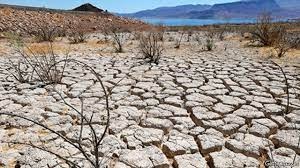
Aisi drought ki condition mein food aur fodder ki availability bhi difficult ho jati hai. Drought hone par logo ko aur animals ko bahut difficulties face karni padti hai isliye hamein water carefully use karna chahiye taki yeh problems arise na ho.
How Can We Conserve Water?
Aise toh earth par bahut sara water present hai lekin usme se ek bahut hi small fraction usable hai. Earth par water ka total amount toh same rehta hai lekin usable water bahut hi limited hai aur usage ke sath decrease ho raha hai.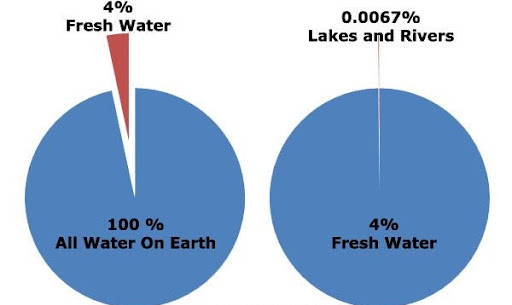
Aaj-kal population bahut increase ho rahi hai jiski wajah se water ki demand bhi increase ho rahi hai lekin water ki availability kum hoti ja rahi hai. Industries mein food production ke liye bhi water ki demand badhti ja rahi hai world ke kuchh parts mein water ki bahut shortage hoti ja rahi hai. Isliye hamein water ko bahut carefully use karna chahiye, usko bilkul bhi waste nahi karna chahiye.
Next topic mein hum rain water ko conserve karne ke baare mein padhenge.
Rainwater Harvesting
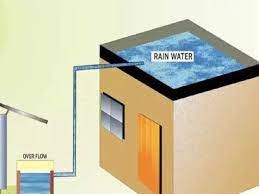
Rainwater ko collect karke water ki availability ko increase karna aur usko bad mein use karne ke liye store karke rakhna, iss process ko hi hum rainwater harvesting kehte hai.
Rainwater harvesting water ko collect karke baad mein use karne ka aur ground water level ko increase karne ka bahut achha tareeka hai. Lekin aajkal mostly places par concrete roads aur buildings ban gayi hai jiski wajah se jo water rain ki form mein earth ke surface par aata hai woh drains mein chala jata hai aur waste ho jata hai kyonki usko wapas use mein laane ke liye bahut efforts karne padte hai. Rainwater waste na ho isliye hum rainwater harvesting ki techniques ke baare mein padhte hai-
POINT 1
Condensation: Condensation is the change of the state of matter from the gas phase into the liquid phase, and is the reverse of vaporization.
Evaporation: Evaporation is the process of changing from a liquid or solid state into vapor (like fog, mist, or steam).
Transpiration: Transpiration is the process of water movement through a plant and its evaporation from aerial parts, such as leaves, stems and flowers.
Rainwater harvesting: Rainwater harvesting is the simple process or technology used to conserve Rainwater by collecting, storing, conveying and purifying of Rainwater that runs off from rooftops, parks, roads, open grounds, etc. for later use.
Water cycle: Water cycle is defined as the way that water moves between being water vapor to liquid water and then back to water vapor.
SUMMARY
1.Water is essential for life.
2.Water vapour gets added to air by evaporation and transpiration.
3.The water vapour in the air condenses to form tiny droplets of water, which appear as clouds. Many tiny water droplets come together and fall down as rain, snow or hail.
4.Rain, hail and snow replenish water in rivers, lakes, ponds, wells and soil.
5.The circulation of water between ocean and land is known as the water cycle.
6.Excessive rains may cause floods while lack of it for long periods may cause droughts.
7.The amount of usable water on earth is limited so it needs to be used carefully.